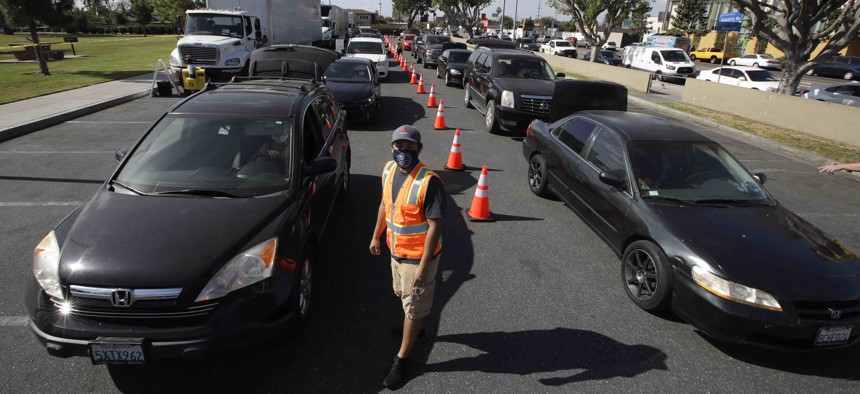Medicaid Rolls and Costs Poised to Grow as Job Losses Mount

Cars line up at a food distribution center Friday, May 15, 2020, in Compton, Calif. AP Photo/Marcio Jose Sanchez

Connecting state and local government leaders
New estimates indicate that upwards of 12 million more people could become eligible for the program after losing health insurance they had through their workplace.
The wave of job losses the nation is now seeing due to the coronavirus outbreak will mean that millions of people who were covered previously by employer-sponsored health insurance could become eligible for Medicaid in the coming months, a new report points out.
States and the federal government share Medicaid costs. But the program is a significant expense for states—one that typically grows as enrollment rises. The federal government has taken action to cover extra Medicaid costs while the public health crisis plays out, but some groups that advocate for states would like to see Congress provide additional assistance in this area.
Medicaid is a “countercyclical” program, meaning enrollment and government costs usually go up when the economy sours. Added costs states could face for the program in the current downturn will come as their budgets are squeezed by the sudden and sharp tax revenue losses and unplanned spending that the disease outbreak is driving.
Kaiser Family Foundation researchers say that as of May 2, nearly 27 million people were poised to potentially lose their health care coverage through their workplace following a job loss.
They estimate almost half of these people, about 12.7 million, would be eligible for Medicaid. This figure rises to 16.8 million by January, when unemployment benefits would be set to expire for many people, lowering their incomes and making them eligible for the program.
Medicaid provides health care coverage for lower-income Americans. About 64 million people were enrolled in the program as of last October, according to the Centers for Medicare and Medicaid Services. Thirty-six states and the District of Columbia have expanded the program under the Affordable Care Act, raising the income level at which people can qualify for it.
In 2018, spending on Medicaid totaled about $592 billion, with states picking up about 37% of that total. Between fiscal 2008 and 2018, Medicaid increased as a share of total state spending from 20.5% to 29.7%, according to figures compiled by the National Association of State Budget Officers. The group said that this figure was on track to decline slightly in 2019 to around 28.9%.
The Kaiser Family Foundation analysis says that eight states—California, Texas, Pennsylvania, New York, Georgia, Florida, Michigan, and Ohio—account for just under half of all people who are expected to lose their employer-sponsored coverage.
Five of those eight states—California, Pennsylvania, New York, Michigan, and Ohio—have expanded Medicaid and about 40% of all people eligible for Medicaid among the potentially newly uninsured as of May live in those five states, the report says.
As part of emergency federal coronavirus legislation that has already been signed into law, the federal government will temporarily increase its match rate for the program by 6.2 percentage points, as long as states meet certain requirements.
The National Governors Association and the National Association of Medicaid Directors have both urged congressional lawmakers to further increase this matching rate.
A Democrat-backed bill that has cleared the House would increase the match by 14 percentage points, for a year beginning in July. The prior 6.2 percentage point hike is included in that total increase and would apply between January and the end of June.
Between mid-March and last week, upwards of 38 million people have filed for unemployment.
The left-leaning Economic Policy Institute published a brief on Thursday that said more than a quarter of the workforce in 10 states has filed a claim for unemployment in the past 10 weeks.
Bill Lucia is a senior reporter for Route Fifty and is based in Olympia, Washington.

NEXT STORY: Nearly Half of U.S. Households Lost Some Income During Pandemic





